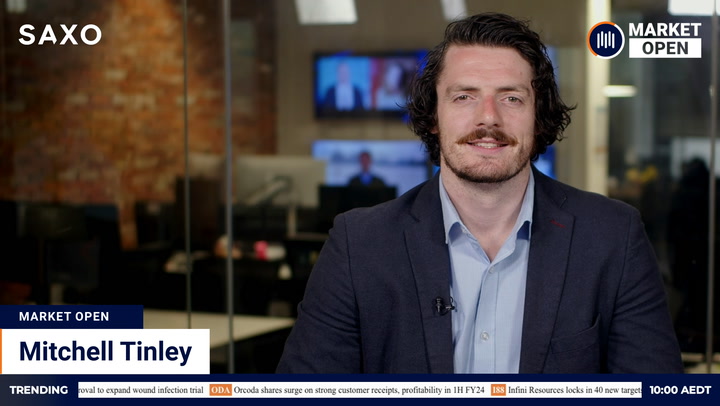The ASX’s longest winning run of the year looked set to continue after apparent progress in Russia-Ukraine ceasefire negotiations fuelled solid gains on Wall Street.
Futures action pointed to a positive start as the S&P/ASX 200 chases a seventh straight advance. SPI200 futures climbed 56 points or 0.75 per cent.
Crude oil declined after “constructive” talks between Russia and Ukraine. Gold fell to its lowest in almost two weeks. Iron ore traded near a seven-month high. The dollar firmed above 75 US cents.
Wall Street
US stocks rose for a fourth night after Russia announced it would reduce its attack on Ukraine after the first face-to-face talks between the two countries in two weeks. Investors ignored further recession signals from the bond market.
The S&P 500 climbed 56 points or 1.23 per cent to a fourth straight gain. The Dow Jones Industrial Average advanced 338 points or 0.97 per cent. The Nasdaq Composite led with a rise of 265 points or 1.84 per cent.
Investors seized on signs of progress towards ending the Russia-Ukraine war. Russia’s Deputy Defence Minister announced it would “drastically” cut back operations near Kyiv and another northern city. Alexander Fomin said the offer was intended “to increase mutual trust and create conditions for further negotiations”.
“A sense of positivity returned to financial markets as the prospects of more cease-fire talks between Russia and Ukraine soothed investor jitters,” Lukman Otunuga, senior research analyst at FXTM, said.
The White House noted Russia had not followed through on previous offers to withdraw and would be judged on actions, not words. Any move from Kyiv might lead only to troops redeploying elsewhere.
Oil retreated, easing one significant pressure on inflation. Traditional “war havens” such as gold and silver declined. Wheat prices also dropped. Both Russia and Ukraine are major grain producers.
Markets largely ignored the first yield curve inversion since 2019. The yield on the ten-year US treasury dipped briefly below the two-year yield. This inversion of the normal relationship between the two assets has preceded every recession in the last 40 years, according to Investing.com.
UBS said the US economy could still avoid a recession, but investors should review their portfolios.
“Our base case is that the US economy can avoid a recession, lowering the threat of a sustained downtrend in stocks,” Mark Haefele, chief investment officer at UBS Global Wealth Management, told clients.
“As such, investors should brace for higher rates—including potentially adding exposure to value and financial stocks which tend to outperform as central bank policy tightens—without overreacting by exiting equity markets.”
Wall Street has regained all of its losses since the start of the Ukraine war. The S&P 500 has bounced more than 10 per cent since March 14. Last night’s rally lifted the broadest of the major US indices to its highest since mid-January.
Australian outlook
Merrily we roll along. The recovery on global markets continued overnight as the looming end of the quarter encouraged further institutional buying. Institutional investors have strong incentives to slap more lipstick on a pig of a quarter before tomorrow night’s close.
Incredibly, the S&P/ASX 200 is on the verge of finishing ahead at the end a turbulent three months. Yesterday’s 52-point advance helped lift the Australian benchmark almost 20 points into positive territory for the quarter. Considering the headwinds (war in Europe, surging inflation, bond turmoil, higher rates in much of the world), that would be a phenomenal result.
The Federal Government splashed cash last night ahead of an election. As always, the gist of the Federal Budget was leaked pretty thoroughly in advance. Possible beneficiaries include: retailers (one-off cash bonus for low/middle income earners); construction/engineering firms (infrastructure spending); telcos (investment in rural internet); and mortgage lenders (assistance for first-home buyers).
Ten of eleven US sectors advanced overnight, led by real estate (+2.85 per cent) and technology (+2.06 per cent). The two sectors that matter most here finished higher but near the bottom of the list: materials +0.77 per cent, financials +0.23 per cent.
Energy was the only sector to duck the rally, falling 0.44 per cent as energy prices retreated.
The economic calendar offers nothing market-moving today.
IPOs: three listings originally pencilled in for this week have been pushed back, two into next week and one to a future date to be announced.
The dollar climbed 0.22 per cent to 75.13 US cents.
Commodities
US oil dipped briefly below US$100 a barrel as progress in peace talks sucked some of the “war premium” out of the market. Prices have also been dented this week by a major Chinese Covid lockdown in Shanghai.
West Texas Intermediate fell as low as US$98.44 a barrel before trimming its fall to US$1.72 or 1.6 per cent at US$104.24. The global benchmark, Brent crude, settled US$2.25 or 2 per cent lower at US$110.23 a barrel.
Gold settled at its lowest in almost two weeks during a general retreat from havens. Metal for April delivery shed US$27.60 or 1.4 per cent at US$1,912.20 an ounce.
Silver dropped 1.8 per cent to US$24.736 an ounce. The NYSE Arca Gold Bugs Index firmed 0.84 per cent.
Iron ore traded near seven-month highs amid speculation of further Chinese stimulus measures to cushion the economy from the impact of the Shanghai lockdown.
“Expectations of policy support in China outweighed concerns of weaker demand amid lockdowns,” ANZ commodity strategists said.
The spot price for ore landed in China edged up 28 US cents or 0.2 per cent to US$150.30 a tonne. The most-traded contract on the Dalian Commodity Exchange rose 0.5 per cent to 867.50 yuan and at its peak traded within three yuan of Monday’s seven-month high.
BHP‘s US-traded depositary receipts inched up 0.05 per cent. The miner’s UK stock eased 0.17 per cent. Rio Tinto dipped 0.19 per cent in the US and 0.31 per cent in the UK.
Aluminium and nickel declined amid caution at the prospect of a ceasefire breakthrough. Russia is a major producer of both metals.
Benchmark aluminium on the London Metal Exchange skidded 4.78 per cent to US$3,441.15 a tonne. Nickel declined 3.33 per cent to US$31,900.
Copper edged up 0.1 per cent, lead 0.87 per cent and tin 0.06 per cent. Zinc shed 0.98 per cent.





